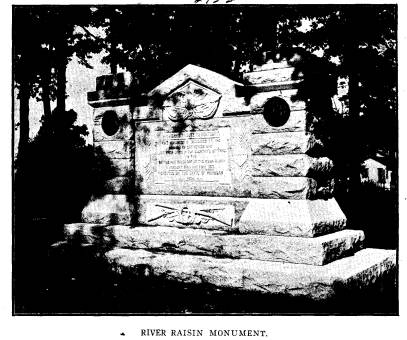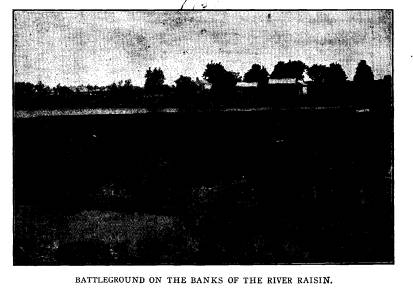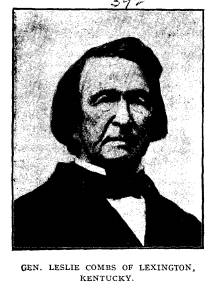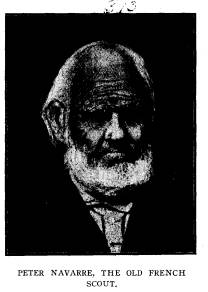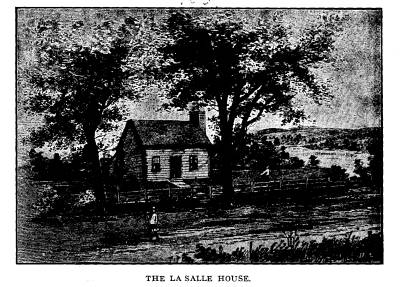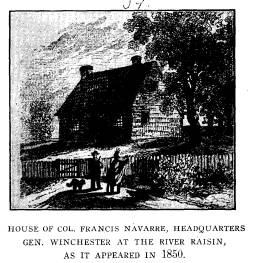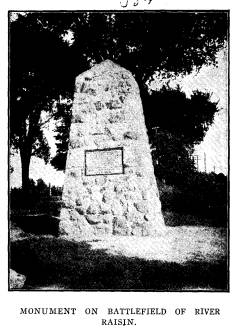Ohio History Journal
|
THE RIVER RAISIN MONUMENTS AT MONROE, MICHIGAN.
JOHN M. BULKLEY. The erection at Monroe, Michigan, in September, 1904, of a monument to fitly commemorate one of the most important, |
|
|
|
as it was one of the most tragic events in the history of the Northwest, was a notable occasion in that city, and witnessed by a most distinguished assemblage of men and women of Michi- gan, Ohio and Kentucky. The monument was made possible by the persistent and patriotic efforts of the ladies composing the Civic Improvement League of Monroe, and their influence in (141) |
142 Ohio Arch. and Hist. Society Publications.
bringing about the action by the State
legislature of Michigan,
which made an appropriation of $5,000
and appointed a commis-
sion to carry the work to a successful
issue. This commission
consisted of Hon. H. A. Conant of
Monroe, Ex-Lieut. Governor
John Strong of South Rockwood, and Hon.
R. B. Robbins of
Adrian. The citizens of Monroe undertook
to raise an amount
of money that should be equal to
defraying all the expenses of
properly and becomingly dedicating the
monument, and all other
expenses aside from the bare cost of the
monument itself. This
was patriotically accomplished, and the
occasion was one reflect-
ing the highest credit upon the city and
one long to be remem-
bered. The principal oration was by Hon.
J. C. Burroughs, U. S.
Senator from Michigan, and addresses
were made by the Hon. H.
V. McChesney, Secretary of State of
Kentucky; the Hon. Thos.
T. Crittenden, Kansas City, Mo., and
Colonel Bennett H. Young
of Louisville, Ky.
The site of the monument which was fixed
by the enact-
ment providing for the memorial is in a
beautiful new park
on Monroe Street, where the bones of
many of the massacred
were buried, near the Toledo and Monroe
thoroughfare, and well
within view of passengers on the
Detroit, Monroe & Toledo
Short Line Electric Railway. It is built
of granite, massive and
graceful in its proportions, bearing
upon the east front pilasters
the State seals of Kentucky and Michigan
in bronze, with the in-
scription which follows, upon the broad
panel:
MICHIGAN'S TRIBUTE TO KENTUCKY.
THIS MONUMENT IS ERECTED
TO THE
MEMORY OF THE HEROES WHO
LOST THEIR LIVES IN DEFENSE OF OUR
COUNTRY
IN THE BATTLE AND MASSACRE AT THE RIVER
RAISIN,
JANUARY 22-23, 1813,
ERECTED BY THE STATE OF MICHIGAN,
1904.
The completed monument, while it is not
pretentious or elab-
orate, speaks to the beholder in a
language that impresses him
The River Raisin Manuments. 143
with the dignity of its spirit, and the
patriotism and gratitude of
the people who erected it. Really, the
inception of the move-
ment to erect this monument dates for
back into the '70's, and
was the outgrowth of another remarkable
assemblage in Monroe.
In the year 1872 a most notable
gathering which probably
has no counterpart in history took place
in Monroe, at a cele-
bration of the Fourth of July, when
nearly one hundred of the
survivors of the massacre, gray haired
men from Kentucky and
Ohio, were present, whose ages averaged
above 75 years. One
of those who attended this reunion was
General Leslie Combs,
who was at the time 91 years of age,
vigorous as a man of half
those years. General Custer was master
of ceremonies, and
Chief Justice James V. Campbell was the
chief orator who ad-
dressed an assemblage estimated at 20,000 people. The
occasion
is remembered as the greatest and most
interesting celebration
ever held in Southern Michigan. One of
the most remarkable
feats in connection with this event was
the success attending the
transportation of this large number of
men of advanced age such
long distances and returning them to
their homes without the
occurrence of an accident or a case of
illness.
At that reunion and celebration it was
proposed to follow
it up immediately by a movement to erect
a monument. This
proposition, under the patriotic
impulses of the occasion, met
with spontaneous and enthusiastic endorsement,
but like many
another well conceived and meritorious
scheme it was allowed
to rest, until through lack of prompt
and concerted action, inter-
est flagged and was before the end of
the year practically forgot-
ten. After a lapse of thirty years it is
a living certainty.
Of the tragedy itself, which by its
cause, the unspeakable
barbarity of its perpetration and by
reason of the unparalled
circumstances of heroism of the men of
our sister state may well
be counted a national one, it may be not
inappropriate to speak
briefly in this article.
Whatever may be said of the failure to
connect the events
with the British authorities of the home
or colonial government,
there is absolutely no palliation of the
outrageous conduct of
the officers in command of the British
forces, and their savage
allies, whose atrocities no effort was
made to control or check.
|
144 Ohio Arch. and Hist. Society Publications.
To return for a brief glance at the occurrences, immediately preceding the war, we find that it was determined, if possible by the participators in the profits of the old monopolies, to retain Michigan at least in its old relations of trade, if not of govern- ment. By Jay's treaty estates were to be protected without for feiture in consideration of exchange of allegiance. Purchases of lands from Indians were forbidden by the laws of both coun- |
|
|
|
tries. But, between the date of that treaty and the change of possession, titles were obtained or fabricated with the immediate co-operation of persons connected with the local government, whereby the Indians purported to grant Detroit merchants all the land between the Sandusky and the Central meridian of Mich- igan as far north as Saginaw Bay, including the whole tract anciently known to the French and Indians as Saginaw county, then supposed to be the richest fur country in America. Know- ing the illegality of these purchases, the conspirators devised a notable scheme of corruption. In 1795 they organized a company to purchase of congress, for a nominal sum, the entire lower peninsula of Michigan; the first step being the preliminary pur- |
The River Raisin Monuments. 145
chase of members enough to carry through
the measure. They
were unfortunate in this effort, as the
members whom they ap-
proached, appearing to fall in with the
scheme, led them on to
a full disclosure and then exposed them.
The disappointed agents
were let off with a light punishment for
contempt by the house
of representatives.
The men engaged in this scheme as
partners, elected, by an
agreement in writing, under Jay's
treaty, together with most of
the business men (traders) of Detroit,
to retain their British alle-
giance, the object of which can easly be
guessed.
What was before a matter of policy
became, now, one of
border feud. The old agents of mischief
were still alive, and
kept stirring the Indian tribes to war
with the whites.
There was throughout the whole country a
growing belief
that Great Britain would lose no chance
of doing us an injury,
and that she was no more friendly than
before. Our ships were
exposed to search, and our seamen to
imprisonment on the high
seas, and hostile emissaries, whose
faces had long been familiar,
were seen prowling among the lodges of
the savages. The de-
tection of Henry's mission to detach the
Northwestern States
from the Union showed that the Canadian
magnates were in-
triguing on their own account, without
the sanction of the home
authorities. But the people drew no nice
distinctions in these
matters; and when General Harrison
defeated the Indians at
Tippecanoe, and foiled the scheme of Tecumseh,
that battle was
always connected in the popular mind
with the War of 1812,
which opened soon after. The war was not
unexpected, but by
a series of blunders and neglects, its
opening scenes in this
neighborhood were full of misfortune.
The schemes already
mentioned, as was intended, kept down
the members of the bor-
der population, so that it could not
defend itself.
The backwoodsmen, scattered through the
Northwest, as
ready with the rifle as the axe, were
eager to take part in the
fray. A war on the frontier required a
different style of pro-
ceedings from one in an older settled
country; and men who had
for years held their lives in their
hands, not knowing at day-
break that the sun would ever again rise
upon their homes, or
whether the torch and tomahawk would end
all forever for them
Vol. XV- 10
|
146 Ohio Arch. and Hist. Society Publications.
and their families--these needed leaders of their own stamp, at once vigilant, prompt and daring. During the following winter the inhabitants of Frenchtown (now Monroe, Michigan) and all the smaller settlements in the vicinity of the River Raisin, were subjected to great annoyances and indignities from the Indians, and were threatened with all the evils of savage cruelty. Proctor, who now commanded in this part of Canada, appears to have had none of the soldierly or manly qualities which characterized Brock, his predecessor in com- |
|
|
|
mand. He gave full license to his barbarous and savage asso- ciates, and their outrages alarmed the whole frontier. At the urgent appeal of the people of Frenchtown, Gen- eral Winchester sent up from his camp on the Maumee a force of between 600 and 800 men, under command of Col. Lewis, who arrived with his force on January 18th, 1813. On the day this command left camp, Winchester prepared a dispatch to inform General Harrison of this movement, stating that his prime object was to prevent the flour and grain being carried off by the |
|
enemy; then, if he got possession of Frenchtown he intended to hold it, and that a co-operating force from the right wing might be necessary. Before the express started with this letter, informa- tion was received from Col. Lewis, a distance of twenty miles in advance, that there was a force of 400 Indians at the River Raisin, and that Col. Elliott was expected from Maiden, with a detachment to attack the camp in the Rapids. Colonel Lewis marched rapidly to anticipate, if possible, Colonel Elliott at Frenchtown. The route lay over the ice of Maumee Bay, and along the shore of Lake Erie. When arriving |
|
The River Raisin Monuments. 147
within a quarter of a mile of the village the enemy was discov- ered in motion. Our troops were formed in line of battle expect- ing an immediate attack, but it was soon perceived that the enemy did not intend to risk a battle in the open field. Our men then assumed the offensive, and a general charge was ordered. The British regulars made a stand with their howitzers and small arms, covered by low palisades of enclosed lots and a group of houses, having in their rear a thick wood filled with fallen timber, The engagement soon became general, and continued hotly con- |
|
tested for over three hours, during which time they were driven back nearly two miles in a northerly direction through the village, and over the river, every foot of the distance un- der charge. Darkness pre- vented further pursuit, and our men withdrew in good order encamping upon the ground which the enemy first occupied. General Leslie Combs, of Kentucky, was with these troops on the staff of General Winchester as aid, being then about eighteen years of age. Many of the particulars of this tragedy were obtained from |
|
|
him by the writer when he was the guest of the citizens of Mon- roe in 1872. He describes the action of the troops as gallant in the extreme, fighting with the greatest courage, which, follow- ing the terrible privations endured on the march through the wilderness for weeks, poorly clad, and scantily fed, displayed the heroism and powers of endurance more plainly than language can depict it. The loss of the Americans was twenty-five killed and fifty-five wounded; that of the enemy could not be ascer- tained, and probably never was known by our officers, but from the number found on the field where the battle commenced and |
|
148 Ohio Arch. and Hist. Society Publications. from the bloody trails on the snow where they dragged off the bodies of their dead and wounded the slaughter must have been great. Immediately after the engagement an express was sent to convey the news to General Winchester, and another to Gen- eral Harrison, in hopes that reinforcements might be sent in time to hold the place against another attack by a larger force of the enemy. The situation was critical, for the lake and streams were frozen sufficiently to bear any weight, and the distance to Malden being but eighteen miles the way was not impeded. |
|
|
|
On the evening of the 20th, General Winchester arrived with about 300 men, all that could be spared from the Rapids, and encamped in an open space near the former detachment. Colonel Wells, of the Seventeenth United States Infantry, com- manded the reinforcement. General Winchester established his headquarters at the house of Colonel Francis Navarre on the south side of the river about one hundred rods from the camp. (See cut on Page 149.) It was not considered necessary to fortify their position that night, but it was determined to do so on the following day. Leslie Combs |
|
The River Raisin Monuments. 149
said of this circumstance to the writer: "I always considered it very remarkable that General Winchester should have fortified his camp every night on our march through the wilderness of Ohio and Indiana, when no enemy was near, and yet failed to do so on the night of the 21st while almost within hearing of the British guns at Malden." Major Madison and Colonel Lewis together with most of the officers had cautioned their men to be on the lookout and prepared for an attack. Guards as usual were out, but as the cold was very severe, no picket guard was placed upon the |
|
road by which it was most probable the ene- my would approach. This fatal neglect was bitterly repented of the following day. "At daybreak," says another informant, "on the morning of the 22d, just as the drums began to beat, three guns were fired by the sentinels. In an instant the men were at their posts. The British now began to open a heavy fire of cannon and small |
|
|
arms. They appeared to direct the fire mostly at the building, which contained the ammunition and where the wounded officers lay. Every circumstance attending this awful scene rendered it more alarming; the time and manner in which it was commenced -for they approached in the darkness with profound silence- the surprise was complete, and the result simply terrible. The roar of musketry, and the enemy's cannon, the flying of bombshells, the yells and whoops of the savages, the cries, shrieks and groans of the wounded all in the heavy darkness, made up a scene but little short of pandemonium itself." |
150
Ohio Arch. and Hist. Society Publications.
The reinforcements which arrived with
General Winchester,
and which were unprotected by
breastworks, after maintaining
their position a short time, were
overpowered and fell back. Just
at this time General Winchester came up
and ordered the re-
treating troops to rally and form behind
the second bank of the
river and inclining toward the center,
take refuge behind the
stockade. These orders may not have been
understood, and,
being hard pressed both by the Biritish
and Indians in front,
and on their right flank, they were
completely thrown into con-
fusion, and retreated southward in
disorder over the river.
A detachment which was sent from the
pickets to reinforce the
right wing, and a few others who
supposed the whole army was
ordered to retreat, joined in the
flight. Colonels Allen and Lewis
both followed, endeavoring to rally the
troops. The Indians had
taken possession of the woods on the
south side of the river and
completely cut off their retreat, and
the alternative presented itself
either to fight a vastly superior force
at great disadvantage or
to retreat to more favorable ground.
In this dilemma, confusion reigned and
the soldiers were
shot down on every side. A rally was
finally effected, and the
men fought with the greatest courage and
heroism, but Winches-
ter, evidently demoralized, exhausted
and intimidated, too, by
Proctor's threats to let loose the
savages on the inhabitants, un-
less he surrendered unconditionally,
gave the order for the whole
command to lay down their arms. The
surprise and indignation
of the officers and men knew no bounds,
and Majors Madison
and Graves bluntly refused to obey,
saying that they would ac-
quiesce in no surrender except on
conditions which would save
the sick and wounded from distress, the
inhabitants from plunder
and preserve the self respect of the
troops. Proctor refused to
agree in writing, but pledged his honor
as a soldier and a gen-
tleman, that these conditions should be
observed. Madison little
knowing the perfidy of the man with whom
he was treating
trusted him, and capitulated. Before the
surrender even, the plun-
dering began by the Indians. The wounded
were left at French-
town, when the British with their
prisoners, started towards Mal-
den, but no guard was provided for their
protection from the
outrages of the savages. Proctor had
promised to send sleighs
The River Raisin Monuments. 151
to convey them to Malden, the next day,
but none ever came.
Instead, however, there appeared about
three hundred half drunk
and frenzied savages screaming and
yelling and brandishing their
knives and tomahawks in a frightful
manner. It had plainly
been determined to kill and scalp all
who could not make their
way on foot. The scene that followed
cannot be adequately de-
scribed, say those who survived.
Many of the wounded were slaughtered in
their beds, some
were burned with the houses that
sheltered them, or tomahawked
in trying to escape from the flames.
Plunder was the first object
and nothing was left untouched; blankets
were stripped from
the sick and wounded; defenseless
prisoners, women and children
all were treated alike, and when nothing
remained for them to
steal the awful scenes of butchery
commenced.
Peter Navarre, a French scout attached
to Harrison's army.
was with the troops and was a witness of
the massacre. From
him a thrilling account of the affair
was obtained just before
his death, which occurred at Toledo in
1879. He was born in
Detroit in 1786, where he lived with his
grandfather, Robert
Navarre, who was a native of France, a
descendant from the
best families of the old monarchy. He
was a man of great en-
durance, never it is said, having been
sick a day during the whole
of his long and eventful life. His
memory was undimmed, and
the events of seventy years were as
clear as those of but recent
occurrence. He states that he stood near
the house in which
Captains Hart, Hickman and others of the
Kentucky officers were
confined, when the former came out and
stood in the snow in his
bare feet, pleading with his captors for
his own life and those of
his countrymen.
Several proposals for their own safety
were made by the
captives, offerings of money and houses,
to be given on their
safe arrival at Detroit. But all these
were treated with contempt
and derision. Captain Hart then asked
what was to be done
with the prisoners left behind. The
reply was, "Boys, you are
all to be killed and scalped."
The brave Hart received this appalling
declaration with
wonderful coolness and composure, and
turned to enter the house
just as a powerful Indian dragged out
the dead body of Major
152
Ohio Arch. and Hist. Society Publications.
Hickman. "The last I saw of Captain
Hart," said Navarre, "he
was standing under the great elm tree in
front of the house where
the prisoners were confined, and an
Indian was in the act of
raising his tomahawk to strike him to
the earth; and it was here,
doubtless, that the brave Kentuckian met
his death."
The carnage went on, now unrestricted,
and none were
spared except to have their miseries
prolonged by tortures along
the frozen and snow covered road towards
Malden, which place
very few reached. The news of the
terrible disaster, as may
be supposed, filled Kentucky with
mourning and the cries of
mothers, widows and orphans were heard
in every community.
The news at Lexington was received while
the people were at
the theatre. The greatest consternation
prevailed and the audi-
ence left the house. The best blood of
the country had been
poured out like water. Col. Allen stood
at the head of the legal
profession, Captain Simpson had just
been elected to congress,
Major Graves, of the volunteers, Captain
Hart, a brother-in-law
of Henry Clay, and Captains Mead and
Edwards, of the Seven-
teenth U. S. Infantry, previously
distinguished at the Battle of
Tippecanoe, under Colonel Davies,
besides scores of others from
the best families in the state, either
fell in battle or were wounded
and afterwards massacred.
Throughout the whole west arose the cry
of vengeance. The
rally to arms was made with the fixed
purpose that their weap-
ons should not be laid aside until red
and white savages alike,
should yield to the arms of
civilization, and the soil where their
brothers were slaughtered should be
purged of every vestige of
British and Indian sway.
The war cry, "KENTUCKIANS, REMEMBER
RIVER RAISIN!"
became a terror to all foes.
On the 5th of October following, the
battle of the Thames
was fought, where the cowardly Proctor
fled, and Tecumseh was
slain. The combined forces of British
and Indians were routed.
The Indian Confederacy was dissolved and
the warriors deserted
the British for the "Long
Knives," while General Harrison's
kindness to the starving tribes
completed the conquest, and the
future of Michigan and the Northwest was
secured.
|
The River Raisin Monuments. 153
THE MONUMENT ON THE BATTLE GROUND OF THE RIVER RAISIN AT MONROE, MICHIGAN. On the north bank of the River Raisin in Monroe, Michigan, has been erected an |
|
appropriate and im- pressive pile to mark the site of the two battles which were fought there; this too was done mainly through the in- strumentalities of the women who compose the Civic Improvement So- ciety of Monroe. The monument is built of the native field bowlders found in the vicinity, laid in cement and rises to a height of about twelve feet, having a base some eight feet square and a pyramidical apex. Upon the east and west faces are oblong tablets of polished gran- |
|
|
ite with these inscriptions in relief: Inscription on the west side shown in accompanying cut:
SITE OF THE BATTLES OF JAN. 18-22 AND OF THE RIVER RAISIN MASSACRE. JANY. 23, 1813. ERECTED BY THE CIVIC IMPROVEMENT SOCIETY OF THE WOMEN OF MONROE, MICH. 1904. |
154 Ohio Arch. and Hist. Society Publications.
Inscription on the east side:
800 AMERICANS UNDER COLONELS LEWIS,
ALLEN AND
WELLS FOUGHT DESPERATELY AGAINST 3,000
BRITISH
AND ALLIES. FORCED TO SURRENDER, AND
THO'
PROMISED PROTECTION, THE PRISONERS, LEFT
UN-
GUARDED, WERE ATTACKED AND KILLED BY THE
INDIANS.
The monument which was unveiled in
October, 1904. stands
on the river's bank, a conspicuous
object in plain view from the
trains which pass a few hundred feet
distant, and directly beside
the line of the Detroit, Monroe and
Toledo Electric Railway.
While it commemorates the rugged
bravery, the wonderful
fortitude and chivalry of that gallant
band of Kentuckians who
made their way through a trackless
wilderness amid the rigors
of a northern winter to respond to the
appeals for help from the
defenseless settlers on these remote
outposts of civilization, it
also with equal justice bears witness to
the cowardice and base-
ness of the conscienceless victor.
It were well if this dark page in the
annals of our country
could be expunged, but history deals
with facts, not sentiment.
Monroe, Mich.
